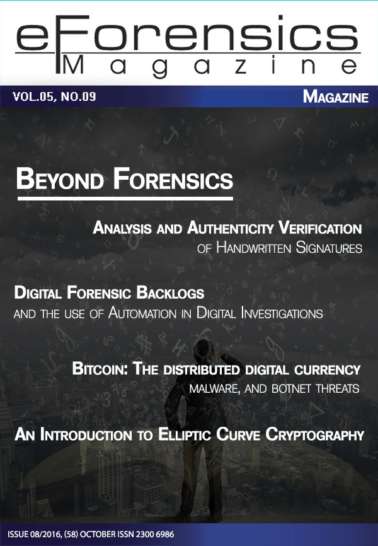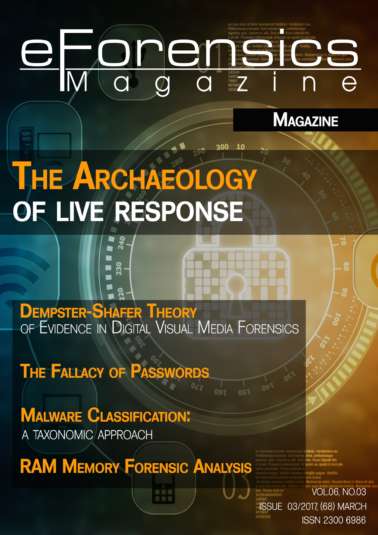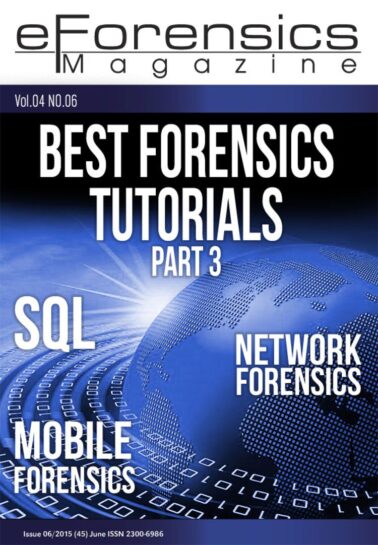No products in the cart.
Download
| File | |
|---|---|
| eForensics Magazine 2019 02 OSINT in Forensics PREVIEW.pdf |
Dear Readers,
We’re happy to share with you the newest issue of eForensics Magazine - OSINT in Forensics.
Open source intelligence has a lot to do with digital forensics, and we’re going to show you how true that is in this edition. Inside you can find articles on How to find missing persons using OSINT, Leveraging Open Source Intelligence for Digital Forensics and Incident Response, and Adopting a Hacker Mindset and Enhancing a Penetration Test through OSINT.
Also, you’ll read about Honeypotting Threats for Security Research and Defense Improvement, learn something about Geolocation Forensics, and come into possession of Autopsy 4.x guide.
That’s not everything, of course, but you should see for yourselves!
As always - we want to thank all authors, reviewers, and proofreaders for participating in this project.
Have a nice read!
Regards,
Dominika Zdrodowska
and the eForensics Magazine Editorial Team
TABLE OF CONTENTS
Using OSINT to locate missing persons
by Joshua Richards
This report will discuss a variety of different OSINT techniques you can use to find information about people online. One example is when a missing person was being investigated. No one could find her, but what could be found was her online identity. An account was found where she had posted just the day before she went missing, stating that she had witnessed something horrible and that she felt her city wasn’t safe anymore. This was a good indicator that she had run away rather than being the victim of a crime.
Honeypotting Threats for Security Research and Defense Improvement - An introduction on how to deploy honeypot instances and benefit from the acquired malicious activity
by Jefferson Souza Macedo
Do you know what a honeypot is, or a honeytoken and their benefits for security industry and business research purposes or even to protect your network against some known and other unknown threats and attackers? This article presents concepts, questions and answers, as well as practical exercises on how to correctly deploy and get benefits while using honeypot resources.
Autopsy 4.x, the GUI forensic analysis suite
by Marco Alamanni
In this article, we will see an open-source, free and multi-platform program to analyze forensic images, that is Autopsy.
Geolocation Forensics
by Brett Shavers
Everything in this article addresses methods and techniques to place a person (or a device) at an exact physical location, anywhere on the planet. Varying methods have varying degrees of accuracy and varying degrees of reliability. When there is only one source of geolocation data, the reliability may not be as accurate or reliable when there are several sources of corroborating data sources. With that, how close can we get in narrowing down a person or device to a specific physical location?
The issues and difficulties in locating a Cyber criminal
by Jose Alfredo Llerena
Nowadays, with highly advanced technologies and the correct tools, many Cyber crimes can be resolved, those approaches on the other hand are totally opposite. In this article, I will expose the difficulties an independent or freelance digital forensic investigator from a developing country faces during a cyber crime investigation.
Leveraging Open Source Intelligence (OSINT) for Digital Forensics and Incident Response (DFIR)
by Collins Bunde
Malware analysis requires intelligence. Security companies, like Payload Security, provide open source intelligence of malware signatures and patterns through their hybrid malware analysis platform. The ability to gather intelligence from publicly shared information is how digital forensics and incident response leverages on open source intelligence when investigating crime. In this case, DFIR teams use signatures, blacklists, and activity patterns to proactively investigate forensic cases. The approach can either be target centric or actor centric focusing on attacker (TTPs). These results in what incident responders and security analysts would term as proactive DFIR, or intelligence driven Incident response.
Digital Traces of Employee Intellectual Property Theft Through the Cloud
by Tyler Hatch
In reality, the most common threat to many businesses comes from within. Their most trusted resource - its employees. Figures suggest that a surprisingly high number of employees have stolen data, intellectual property and confidential information from their employer. For example, one source states that 56% of employees steal information, data or intellectual property from their employer when departing the organization. While the motivation for the theft ranges from retribution to a desire to compete with their former employer - and everything in between - the sheer volume of workplace theft cannot be denied.
Potential Cyber Forensics Specialties 2025
by Kevin Coleman
We are rapidly moving to a highly connected world. Singularity Hub reported that by 2025 there will likely be 100 billion connected devices. Some even call it the "trillion-sensor economy." Multiple sources have estimated all those connected devices will cause data to explode to between 160 and 170 zettabytes by 2025 - that has so many 0s (zeros). That is about a 10X increase from today. Some believe that over one-quarter will need real-time processing and analytics. This is causing the value of data to increase along with the volumes that need to be protected, as well as the software and systems that produce and analyze all that data. All of these devices and this data will result in forensics becoming far more challenging with an increased emphasis on the damages due to data theft and manipulation. Most of all, the likelihood of hacking and data manipulation that results in the loss of life is a real concern.
Adopting A Hacker Mindset and Enhancing a Penetration Test Through OSINT
by Matthew Kafami
This article will provide a brief overview of how to use open source intelligence (OSINT) to further supplement the process of penetration testing. While standard procedures and tools used in penetration tests work just fine, using data gathered through OSINT collection can assist the process by allowing a penetration tester to tailor messages and payloads for use in phishing attacks as well as creating more customized rainbow tables for password cracking.
Is AI a cybersecurity panacea? Advantages and limitations of AI-driven cyber hygiene
from TechWarn
Artificial intelligence, or AI, is without a doubt the world’s most controversial technology. And with so many wild claims circulating about the power of AI, its potential in the field of cybersecurity is easy to overstate. A report released earlier this year by KPMG Singapore found that 86% of CEOs they surveyed believed that AI will become the silver bullet for cybersecurity.
7 reviews for OSINT in Forensics
Only logged in customers who have purchased this product may leave a review.





Wolfgang Sesin (verified owner) –
I started first reading with the hakin9 magazine in about mid 2000 and these days I buyed two eforensics magazines and one was OSINT which is very informative and professional written. I am looking forward in reading the next issue. Would be glad to know if a premium vip subscription will be offered too?
Kevin –
eForensics Magazine enables those involved in this profession the ability to keep pace with the massive change that is taking place and impacting the needed knowledge and skills of their readers.
Tyler Hatch –
I enjoy eForensics Magazine personally but learn something valuable professionally in every issue! I particularly enjoyed the article on “Honeypotting Threats” in this issue but all the articles were fantastic and relevant to our field.
Brett Shavers –
The OSINT issue did a good job of putting together related articles with different perspectives, and I am glad to have been able to provide some useful material in this issue. Any magazine in this field has tremendous task to keep content going, and I am glad to see eForensics Magazine continuing moving forward :)
Joshua Richards –
This issue of the magazine has been my favourite so far in terms of the content because OSINT is a real interest of mine. It was an honor to be a part of it and from reading the other articles, I know all the other writers in this issue are very experienced and I’m sure everyone can learn something from these people. The range of knowledge throughout these articles is huge so whether it is using certain tools, techniques, or just learning some theory about a topic, it is all here in this issue of the magazine. I highly recommend it!
Matt Kafami –
“Geolocation Forensics” by Brett Shavers outlined exactly why modern criminals are almost always caught, they put themselves at the scene of the crime one way or another by leaving a digital footprint. The article did an excellent job of highlighting the various ways technology gives away a person’s location at just about any given time.
Bunde Collins –
These article’s are very insightful, it’s been a pleasure being part of this issue. The thought-leadership in the DFIR field is very imminent from these articles. These are people with vast experience. I am humbled being part of it.